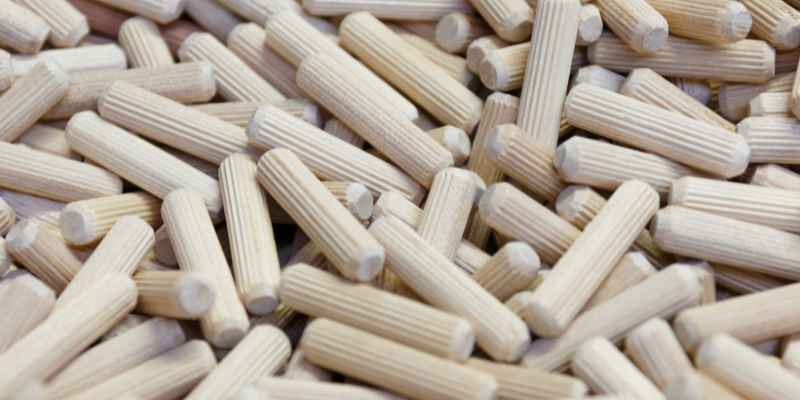Mahogany wood dowels are strong, durable, and visually appealing. They are commonly used in furniture making and woodworking projects.
Mahogany wood dowels stand out for their rich color and fine grain, making them a popular choice among woodworkers. This hardwood is known for its strength and resistance to warping, ensuring long-lasting projects. Craftsmen appreciate mahogany for both its aesthetic appeal and structural integrity.
Whether you’re creating furniture, cabinetry, or decorative items, mahogany dowels provide a reliable and attractive option. Their versatility allows them to fit seamlessly into various designs. Using high-quality mahogany dowels can elevate the overall look of your projects while ensuring they remain sturdy over time. Explore the world of mahogany wood dowels for your next woodworking endeavor.
Introduction To Mahogany Wood Dowels
Mahogany wood dowels are popular in woodworking projects. They are strong, durable, and aesthetically pleasing. Craftsmen and DIY enthusiasts often choose mahogany for its rich color and versatility.
Qualities Of Mahogany Wood
- Durability: Mahogany wood is resistant to wear and tear.
- Stability: It does not warp easily, maintaining its shape.
- Attractive Grain: The wood features a fine, straight grain.
- Rich Color: It ranges from light pink to deep reddish-brown.
- Workability: Mahogany is easy to cut and shape.
Common Uses For Mahogany Dowels
| Use | Description |
|---|---|
| Furniture Making | Used for chair and table construction. |
| Cabinetry | Ideal for doors and drawer slides. |
| Musical Instruments | Common in guitar and piano components. |
| Woodworking Projects | Used for joinery and decorative elements. |
Mahogany dowels are essential for various projects. Their strength and beauty make them a top choice for artisans. Choose mahogany for a lasting and stunning finish.

History Of Mahogany In Woodworking
Mahogany wood has a rich history in woodworking. Its beauty and durability make it a favorite among craftsmen. This section explores the origins and evolution of mahogany in woodworking.
Origins Of Mahogany Use
Mahogany wood comes from tropical trees. These trees grow mainly in Central and South America. European colonists first discovered mahogany in the 16th century.
Here are some key points about mahogany’s origins:
- Used by indigenous people for centuries.
- Valued for its strength and rich color.
- Exported to Europe in the 1700s.
Craftsmen began to use mahogany for fine furniture. Its popularity soared due to its workability and stunning finish.
Evolution In Craftsmanship
As demand for mahogany grew, so did craftsmanship techniques. Early artisans shaped mahogany into intricate designs. They crafted pieces that showcased the wood’s natural beauty.
The following table highlights key milestones in mahogany craftsmanship:
| Year | Milestone |
|---|---|
| 1700s | Introduction in European furniture making. |
| 1800s | Rise of intricate carvings and inlays. |
| 1900s | Mass production techniques developed. |
Modern craftsmen continue to innovate. They blend traditional methods with new technologies. This evolution keeps mahogany relevant in today’s market.
Types Of Mahogany Wood
Mahogany wood is well-known for its beauty and durability. Different types of mahogany have unique features. This section explores the main varieties and their characteristics.
Varieties And Species
Mahogany belongs to several species. Each species has distinct traits. Here are the most common varieties:
- Swietenia macrophylla – Also known as Honduras mahogany. It is popular for furniture.
- Swietenia mahagoni – Known as Cuban mahogany. It has a rich, reddish-brown color.
- Swietenia humilis – Also called West Indian mahogany. It is less common and smaller.
Each species offers unique qualities. Builders and craftsmen choose based on these traits.
Color And Grain Patterns
Mahogany wood displays stunning colors and grain patterns. Colors range from light pink to dark reddish-brown. The grain is often straight but can be interlocked.
| Species | Color | Grain Pattern |
|---|---|---|
| Swietenia macrophylla | Reddish-brown | Straight, fine |
| Swietenia mahagoni | Rich, dark brown | Interlocked |
| Swietenia humilis | Light brown | Straight |
These colors and patterns make mahogany wood appealing. It is perfect for cabinets, tables, and dowels. The beauty of mahogany enhances any project.
Selecting The Right Mahogany Dowels
Selecting the right mahogany dowels is crucial for your project. The quality and size affect the final results. Here are important factors to consider.
Size And Diameter Considerations
Choosing the correct size and diameter ensures strength and stability. Follow these guidelines:
- Standard Sizes: Common diameters include 1/4″, 3/8″, and 1/2″.
- Length: Pick a length that matches your project needs.
- Project Type: Use larger dowels for heavy-duty projects.
Refer to the table below for quick size recommendations:
| Project Type | Recommended Diameter |
|---|---|
| Furniture Assembly | 3/8″ – 1/2″ |
| Cabinet Making | 1/4″ – 3/8″ |
| Craft Projects | 1/4″ |
Quality Assessment Tips
High-quality mahogany dowels enhance durability and appearance. Here’s how to assess quality:
- Grain Pattern: Look for straight and uniform grain.
- Color: Deep reddish-brown indicates good quality.
- Surface Smoothness: Check for smooth, blemish-free surfaces.
Here are some quick tips:
- Inspect for knots or cracks.
- Feel the weight; heavier dowels are usually denser.
- Ask for samples to compare before buying.
Quality dowels ensure strong joints and a beautiful finish.
Working With Mahogany Dowels
Mahogany wood dowels are known for their strength and beauty. They are perfect for various woodworking projects. Understanding how to work with these dowels enhances your craftsmanship. Explore techniques for cutting, shaping, and joining them effectively.
Cutting And Shaping Techniques
Cutting and shaping mahogany dowels requires precision. Use the right tools for clean cuts. Here are some effective techniques:
- Hand Saw: Great for straight cuts.
- Band Saw: Ideal for intricate shapes.
- Table Saw: Perfect for uniform lengths.
After cutting, sanding is essential. Use fine-grit sandpaper for a smooth finish. Start with coarse paper, then move to finer grits.
Joining Methods And Best Practices
Joining mahogany dowels requires careful planning. Choose the right method for your project. Here are popular joining methods:
| Method | Description |
|---|---|
| Wood Glue | Strong bond for most projects. |
| Doweling Jigs | Ensure perfect alignment and spacing. |
| Screws | Great for added stability. |
Follow these best practices:
- Always measure twice before cutting.
- Ensure dowels fit snugly in their holes.
- Use clamps to hold pieces together while drying.
By mastering these techniques, you can create stunning and durable projects. Mahogany dowels will enhance your woodworking skills.
Finishing Techniques For Mahogany
Mahogany wood dowels stand out for their beauty and durability. Proper finishing enhances their natural charm. Learn effective techniques to achieve a stunning finish.
Sanding And Preparation
Sanding is crucial for a smooth surface. Follow these steps for best results:
- Start with coarse sandpaper (80-120 grit).
- Sand in the direction of the wood grain.
- Progress to finer sandpaper (180-220 grit).
- Remove dust with a damp cloth.
Ensure all surfaces are even. This preparation creates a perfect base for stains and finishes.
Stains And Finishes For Mahogany Dowels
Choosing the right stain and finish can enhance mahogany’s natural color. Consider these options:
| Type | Description | Recommendation |
|---|---|---|
| Oil-based Stains | Deep penetration, rich color. | Use for a classic look. |
| Water-based Stains | Quick drying, easy cleanup. | Good for projects needing fast results. |
| Varnish | Durable, adds shine. | Best for protecting surfaces. |
| Polyurethane | Strong, water-resistant finish. | Ideal for high-traffic items. |
Apply stains with a soft cloth or brush. Wipe off excess for a more even look. For finishes, use a clean brush. Apply thin layers for best results.
Let each layer dry completely. Sand lightly between coats for a smooth finish. Enjoy the rich beauty of your finished mahogany dowels!
Creative Projects Using Mahogany Dowels
Mahogany wood dowels are versatile and beautiful. Their rich color and strength make them ideal for various creative projects. From furniture making to decorative crafts, these dowels can enhance any creation.
Furniture Making Inspirations
Crafting furniture with mahogany dowels can be rewarding. Here are some inspiring ideas:
- Table Legs: Use dowels to create sturdy legs for tables.
- Bookshelves: Build custom bookshelves with stylish dowel supports.
- Chairs: Design unique chairs with mahogany dowel frames.
- Cabinet Doors: Add dowel accents to enhance cabinet designs.
Decorative And Functional Crafts
Mahogany dowels can be used for various decorative and functional crafts. Here are some popular projects:
- Wall Art: Create stunning wall hangings using dowel patterns.
- Coat Racks: Make stylish coat racks for your entryway.
- Photo Frames: Build unique photo frames with dowel borders.
- Jewelry Holders: Craft elegant jewelry displays using dowels.
| Project Type | Description |
|---|---|
| Furniture | Sturdy and stylish pieces for home. |
| Decorative Crafts | Unique items to enhance your decor. |
| Functional Crafts | Practical solutions with artistic flair. |
Using mahogany dowels can transform simple projects into stunning creations. Embrace your creativity and explore these ideas!
Maintenance And Care For Mahogany Dowel Creations
Maintaining mahogany wood dowels is essential for longevity and beauty. Proper care enhances their natural charm. Regular maintenance prevents damage and keeps them looking new.
Cleaning And Preservation
Cleaning your mahogany dowels is simple. Follow these steps:
- Dust Regularly: Use a soft cloth to remove dust.
- Use a Mild Soap: Mix soap with water. Dampen a cloth with the solution.
- Wipe Gently: Clean the dowels with the damp cloth.
- Dry Immediately: Use a dry cloth to remove moisture.
Preservation is vital for mahogany. Apply these tips:
- Use Wood Oil: Apply a high-quality wood oil every 6 months.
- Avoid Direct Sunlight: Keep dowels away from direct sunlight.
- Control Humidity: Maintain a stable humidity level.
Repair And Restoration Advice
Even with care, damage can occur. Here are some repair tips:
- Scratches: Use a wood marker to fill scratches.
- Dents: Apply a damp cloth and iron over it.
- Loose Joints: Use wood glue to secure loose dowels.
For larger issues, consider restoration:
| Issue | Solution |
|---|---|
| Severe Scratches | Sand the area lightly and refinish. |
| Discoloration | Use a wood stain to match the original color. |
| Structural Damage | Consult a professional for repairs. |
Regular maintenance ensures your mahogany dowels remain beautiful and functional. Following these tips will help you enjoy your creations for years.
Sourcing And Sustainability
Mahogany wood dowels are popular for many projects. Sourcing them ethically is vital. It ensures forests stay healthy and vibrant. Sustainable practices make sure future generations can enjoy this beautiful wood.
Ethical Sourcing Of Mahogany
Ethical sourcing means getting wood without harming the environment. Here are some key points about ethical sourcing:
- Choose suppliers who follow legal guidelines.
- Check if the wood is certified by organizations like FSC.
- Support businesses that prioritize community rights.
When you buy mahogany wood dowels, ensure they come from reputable sources. This helps protect the forests and local communities.
Supporting Sustainable Forestry
Sustainable forestry practices help maintain healthy ecosystems. These practices include:
- Replanting trees after harvesting.
- Using selective logging techniques.
- Monitoring forest health regularly.
By choosing sustainably sourced mahogany, you support:
| Benefit | Description |
|---|---|
| Environmental Health | Maintains biodiversity and protects wildlife. |
| Community Support | Helps local economies thrive and grow. |
| Quality Products | Ensures high-quality wood for projects. |
Choose mahogany wood dowels that come from sustainable sources. Your choices make a positive impact on the planet.
Future Of Mahogany In Craftsmanship
Mahogany wood dowels hold a special place in craftsmanship. This wood offers beauty and durability. The future looks bright for mahogany in various projects. Artisans and hobbyists continue to embrace its qualities.
Innovations In Wood Dowel Use
Craftsmen are discovering new ways to use mahogany dowels. Innovative techniques enhance both strength and aesthetics.
- 3D Printing: Combining technology with traditional methods.
- Eco-friendly Finishes: Using natural oils and waxes.
- Interlocking Designs: Creating unique joints for better stability.
These innovations make mahogany dowels more versatile. They open doors for unique projects.
Trends In Woodworking With Mahogany
Mahogany woodworking trends are shifting. More artisans prefer sustainability.
- Minimalist Designs: Simple, elegant pieces using mahogany.
- Mixed Media: Combining wood with metal or glass.
- Custom Furniture: Tailored pieces that showcase mahogany’s beauty.
These trends reflect a growing appreciation for craftsmanship. Mahogany remains a favorite among woodworkers.

Frequently Asked Questions
What Are Mahogany Wood Dowels Used For?
Mahogany wood dowels are commonly used in furniture making, cabinetry, and crafts. They provide strength and durability, making them ideal for joinery. Their rich color and fine grain enhance the aesthetic appeal of various projects. Additionally, they can be used in both structural and decorative applications.
How Do You Select Mahogany Wood Dowels?
When selecting mahogany wood dowels, consider the diameter and length needed for your project. Ensure the dowels are straight and free from defects. Look for high-quality wood with consistent color and grain. Finally, consider the finish; a smooth surface will make assembly easier and improve appearance.
Are Mahogany Wood Dowels Environmentally Friendly?
Mahogany wood can be sustainably sourced, making it an eco-friendly choice. Look for dowels certified by organizations like the Forest Stewardship Council (FSC). This ensures the wood is harvested responsibly. Additionally, mahogany’s durability means products made from it last longer, reducing waste over time.
How Should I Care For Mahogany Wood Dowels?
To care for mahogany wood dowels, clean them with a damp cloth to remove dust. Avoid harsh chemicals that can damage the finish. If necessary, apply a wood conditioner or polish to maintain their luster. Store dowels in a dry, cool place to prevent warping or damage.
Conclusion
Mahogany wood dowels offer strength and beauty for various projects. Their durability makes them ideal for furniture and crafts. Choosing high-quality mahogany ensures longevity and aesthetic appeal. Embrace the versatility of mahogany dowels in your next creation. Elevate your woodworking with this premium material and enjoy the results for years to come.

